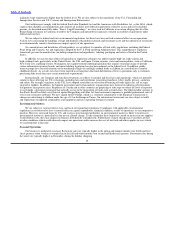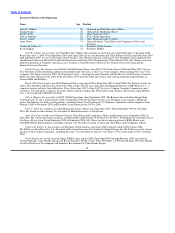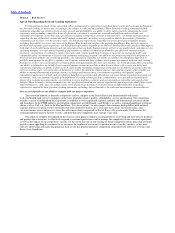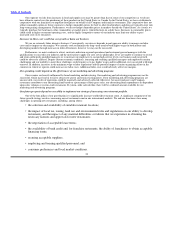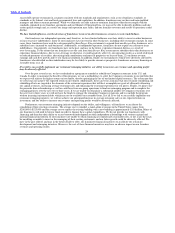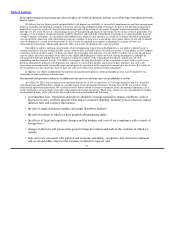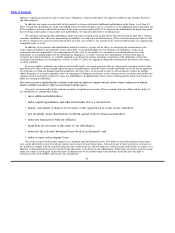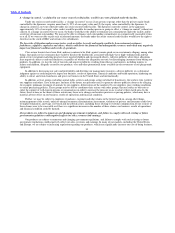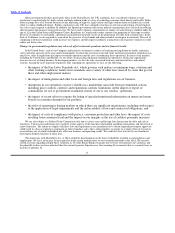Burger King 2010 Annual Report Download - page 26
Download and view the complete annual report
Please find page 26 of the 2010 Burger King annual report below. You can navigate through the pages in the report by either clicking on the pages listed below, or by using the keyword search tool below to find specific information within the annual report.
Table of Contents
successfully operate restaurants in a manner consistent with our standards and requirements, such as our cleanliness standards, or
standards set by federal, state and local governmental laws and regulations. In addition, franchisees may not hire and train qualified
managers and other restaurant personnel. While we ultimately can take action to terminate franchisees that do not comply with the
standards contained in our franchise agreements and our Manual of Operating Data, we may not be able to identify problems and take
action quickly enough and, as a result, our image and reputation may suffer, and our franchise revenues and results of operations could
decline.
We have limited influence over the decision of franchisees to invest in other businesses or incur excessive indebtedness.
Our franchisees are independent operators and, therefore, we have limited influence over their ability to invest in other businesses
or incur excessive indebtedness. Some of our franchisees have invested in other businesses, including other restaurant concepts. In some
cases, these franchisees have used the cash generated by their Burger King restaurants to expand their non Burger King businesses or to
subsidize losses incurred by such businesses. Additionally, as independent operators, franchisees do not require our consent to incur
indebtedness. Consequently, our franchisees have in the past, and may in the future, experience financial distress as a result of
over−leveraging. To the extent that our franchisees use the cash from their Burger King restaurants to subsidize their other businesses or
experience financial distress, due to over−leverage or otherwise, it could negatively affect (1) our operating results as a result of delayed
or reduced payments of royalties, advertising fund contributions and rents for properties we lease to them, (2) our future revenue,
earnings and cash flow growth and (3) our financial condition. In addition, lenders to our franchisees which were adversely affected by
franchisees who defaulted on their indebtedness may be less likely to provide current or prospective franchisees necessary financing on
favorable terms or at all.
If we fail to successfully implement our restaurant reimaging initiative, our ability to increase our revenues and operating profits
may be adversely affected.
Over the past several years, we have embarked on a program to remodel or rebuild our Company restaurants in the U.S. and
Canada. In order to maximize the benefits of this program, we use a methodology to select the Company restaurants in our portfolio that
we expect will achieve the highest return on investment, thereby optimizing the use of our limited capital resources. The restaurants that
we select may not achieve the expected return on investment. Additionally, there can be no assurance that our restaurant remodeling and
rebuilding efforts are targeted at the elements of the restaurant experience that will best accomplish our goals of efficiently allocating
our capital resources, increasing average restaurant sales and enhancing the restaurant experience for our guests. Finally, we plan to use
the proceeds from refranchisings as well as cash flows from on−going operations to fund our reimaging program and to complete the
reimaging projects over the next two to three years. If we are unable to refranchise a substantial number of Company restaurants over
the next two to three years, we will not have the funds to reimage the remaining Company restaurants and to conclude the program
without incurring incremental debt, which may not be available on reasonable terms, if at all. If we fail to successfully implement our
restaurant reimaging initiative, we will not achieve our anticipated increase in average restaurant sales or our expected return on
investment, and our ability to increase our revenues and operating profits would be adversely affected.
Furthermore, our restaurant reimaging initiative depends on the ability, and willingness, of franchisees to accelerate the
remodeling of their existing restaurants. The average cost to remodel a stand−alone restaurant in the United States ranges from
$200,000 to $525,000 and the average cost to replace the existing building with a new building is approximately $1.0 million. Many of
our franchisees will need to borrow funds in order to finance these capital expenditures. We do not provide our franchisees with
financing and therefore their ability to access borrowed funds depends on their independent relationships with various regional and
national financial institutions. If our franchisees are unable to obtain financing at commercially reasonable rates, or not at all, they may
be unwilling or unable to invest in the reimaging of their existing restaurants, and our future growth could be adversely affected. We
have in the past offered, and may in the future decide to offer, our franchisees financial incentives to accelerate our restaurant
development and reimaging initiatives. However, the cost of these financial incentives may have an adverse impact on our franchise
revenues and operating results.
24




